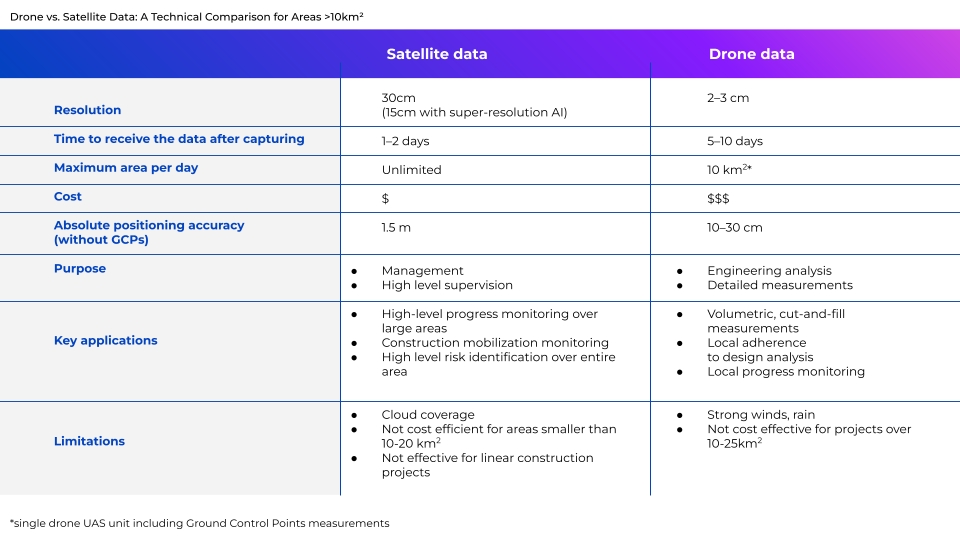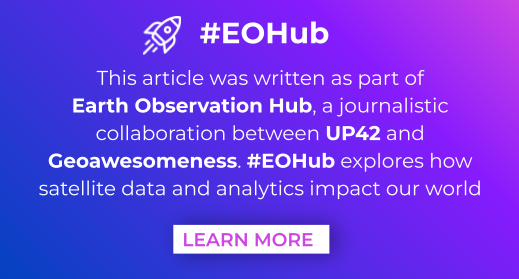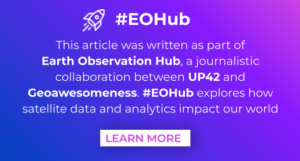
Exploring the role of satellite and drone data in construction progress monitoring
Part 1 in our EO Hub construction series
Historically, the construction industry has lagged behind other sectors when it comes to digitization. However, technological advances are increasingly permeating the construction landscape, with drone technology in particular gaining significant attention.
Recognized for their ability to capture volumetric measurements of earthworks, and with a typical resolution of around 3cm, drones are now a key engineering tool. They can also provide enhanced situational awareness for small to midsize construction sites, as high-resolution data can be captured and processed into orthomosaics and high-density 3D point clouds in as little as 24-48 hours. This has led to the wide adoption of drones by the construction industry.
However, when the area of interest expands to tens—or even hundreds—of kilometers, as is common in mega projects, challenges arise, and the shortcomings of drones are exposed. This is where the power of satellite data comes into play. With 30cm resolution data now available from several constellations, this technology has the potential to perform a significant role for the industry—provided construction stakeholders can overcome their skepticism.
As we embark on a three-part series exploring the potential use of satellite imagery in the construction industry, we begin by comparing the use of drones and satellite data.

Drones: A versatile data-collection tool
Drone technology is already widely utilized in the construction industry. High-resolution aerial imagery and 3D mapping of construction sites facilitate the collection of crucial data, which can add enormous value for multiple stakeholders.
For example, drones can be used in planning, for verification of site conditions or making environmental impact assessments. During construction, they can be used for detailed engineering calculations, including volumetric cut-and-fill measurements. Drones also play a vital role in monitoring schedule adherence, budget management, quality control, and compliance, and can be used for the detection and rectification of planning and execution errors.
One of the most important benefits of drones is in increasing safety. Construction is one of the most dangerous industries globally, with construction workers 3–4 times more likely to die from on-the-job accidents than those in other sectors—rising to 6 times higher in the developing world. Drones can significantly mitigate the risk of injury and death, by enabling firms to access and capture imagery in dangerous, hard-to-reach locations without on-the-ground human involvement.
With companies like Propeller Aero providing data processing and analysis platforms, plus hardware for improving the accuracy of drone surveys, organizations don’t need team of experts to incorporate drones into their workflow. Furthermore, with drones becoming more and more affordable, the entry barrier to their use is lower than ever.
In short, drones are the perfect tool for remotely monitoring sites up to several square kilometers, and with technology advancing rapidly, they have become indispensable to the construction industry. However, they do have limitations. They are not suitable for use in adverse weather conditions—and, most significantly, are not practical for projects over 10-25km2 in area.
Satellites: The macro perspective
Satellites, on the other hand, provide a high-level perspective. Although they may not prove cost-effective for surveying areas smaller than 10-20km2, they hold immense promise for mega projects. These sites can sometimes be hundreds of kilometers in size, and satellites can offer a macro-level overview which are virtually impossible with traditional methods.
Resolution limitations may prevent cm-level surveying, but with resolution of 30cm (or even 15cm with super resolution) now available, the applications of satellite data are rapidly expanding. For example, satellite imagery can aid in the planning stage when investigating potential sites and assessing environmental impacts—UP42 is an example of a platform which gives construction companies a cost-effective way to conduct planning and feasibility studies through its historic collections.
During construction, satellites can be tasked to help firms to monitor productivity metrics on a large scale, or to measure ground deformation as a result of tunneling. Furthermore, satellite imagery can enhance transparency and trust, improving stakeholder communication.

Source: Airbus
Of course, as with drones, satellites have their limitations. They are not ideal for monitoring long, linear projects like roads, and depending on the type of imagery required, they may not be effective when dealing with cloud cover.
Complementary Solutions: Drones and Satellites in construction progress monitoring
By combining the use of drones and satellite technology, construction firms can create a robust, multi-layered system for project monitoring and data-gathering. Each technology compensates for the other’s limitations: the broader coverage of satellite data counterbalances the restricted range of drones, while the high-resolution data from drones supplements the less detailed satellite data.
This synergy between the two technologies can ensure comprehensive progress monitoring, enhance decision-making, and sharpen predictive capabilities. When used in tandem, they can significantly reduce (although not eliminate) the need for on-the-ground monitoring, which can increase safety and efficiency, and potentially reduce costs. With the rapid advances being made in data analysis, unparalleled insights are available to organizations willing to embrace the technology.
The table below summarizes the technical differences between drone and satellite data, and demonstrates clearly that they are complementary, rather than competing technologies:

Conclusion
As the digital transformation unfolds, both drones and satellites hold vast potential for the construction industry, and have the potential to work synergistically as invaluable tools for managing large-scale projects. These technologies herald a revolution in construction progress monitoring, driving efficiency, improving quality, and ensuring that complex mega projects can be completed successfully.
However, challenges remain to widespread adoption of satellite data—not least, skepticism within the industry about both its capabilities and affordability. It’s true that historically satellite data has been prohibitively expensive, with resolution only suitable for the highest level of analysis. However, the industry has come a long way in a short time. Earth observation data providers and thought leaders in the space have a crucial role to play in communicating the giant leaps forward that satellites have made, in terms of resolution, tasking abilities, and in affordability.
Did you like the article? Read more and subscribe to our monthly newsletter!






